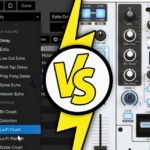Video Review
Professionally constructed in metal with top quality components, and packed with more buttons, knobs and faders than practically any other DJ controller, the Vestax VCI-400 already has many serious digital DJs salivating at mere sight. (Update: There’s now also a VCI-400DJ version for Serato DJ).
We’ve had a week to play with an early production model that Vestax sent to us straight from Japan, and this review and video document our first thoughts on this monster of a controller. Expect us to revisit it later when we’ve had more time with it.
First impressions/setting up
The controller is a little bigger than a Traktor Kontrol S2 (about an inch deeper and wider), but obviously heavier due to being metal, not plastic.
It’s in that group of controllers that are not truly portable due to their size and/or weight, but which are certainly more portable than those in the next size bracket up – and in that group I put the Traktor Kontrol S4, Pioneer DDJ-S1, Pioneer DDJ-T1 and the Numark NS6. You could fit this in a backpack with your laptop, but it’d have to be a big backpack, and you wouldn’t want to be carrying it very far.
It is not the most elegant-looking of controllers simply because it has so many buttons, knobs and faders, making it appear busy and cluttered. However, the build quality can’t be faulted in practically all areas: It has full metal construction, screwed-on silver metal corners, Vestax’s lovely jogwheels (still the best of any, in my opinion), real metal oversized filter knobs, nice squidgy rubber buttons across the front of each deck, and quality knobs for all other surface controls.
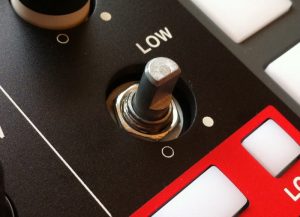
It feels like lesser quality components haven been used for the cue/master and headphones level controls on the front of the unit, however, which are thin plastic and wobbly; but investigation of these (and all other controls, actually) reveals that they are not simply mounted to the circuit board and protruding through the unit like on cheaper controllers, but that they are actually screwed to the palte underneath the faceplate, meaning baiscally that they’re going to last for a very long time. Appearances can be deceptive.
The faders are tipped with plastic silver controls which may be not to your taste, but these are easy enough to replace should you want to add something else.
Enough controls for you?
So control wise, what have we got here? Imagine a decent, middle-range four-channel Traktor DJ controller, one with proper controls over both effects engines. Now add eight big triggers plus four (potential) mode selector buttons, like those on the Novation Twitch, to each deck. Throw in individual filter controls.
Add a comprehensive file browser section with a push-button infinity knob for selection, plus a mini-fader and four extra buttons here. And finally, put four tactile hot cues per deck underneath each jogwheel, alongside the cue and play/pause buttons. Throw in a handful of mic/line inputs and some pro outputs. That’s about the size of it.
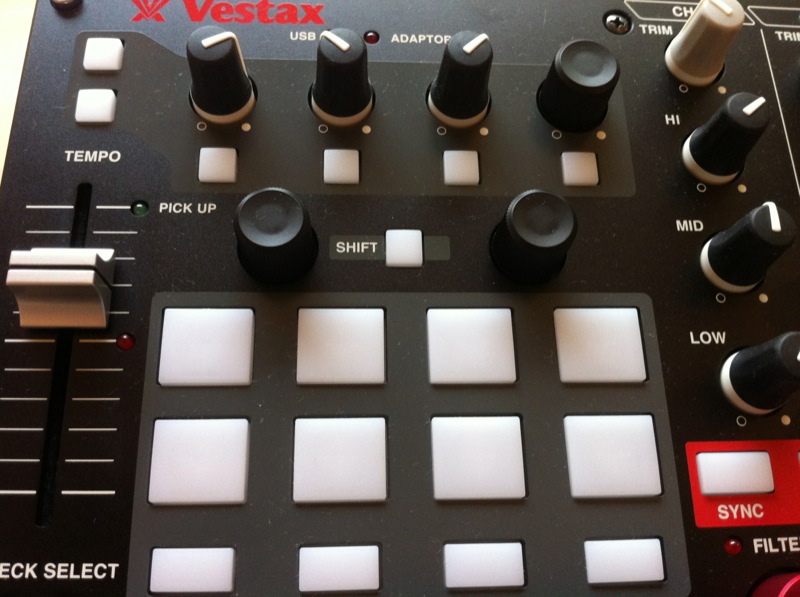
One of the first things that strikes you about many of the above controls is that they’re not labelled; already it is clear that this controller is intended to be customised to do what you want it to do, and is not designed to tie you to a set way of working, at least once you get past the givens.
Indeed, once you spot that it’s got “mode” switches for each deck, each of which has three settings, on top of the usual shift doubling-up of functions, it becomes clear that there are an awesome array of mapping possibilities here for the power user.
So apart from all the Midi controls – which clearly make the VCI-400 a controllerist’s dream – what else have we got?
On the front there are two touch sensitivity adjusters for the capacitive jogwheels – jogwheels which also have tension adjusters in the middle of each to have them as stiff or loose as you wish. There’s a crossfader curve adjuster on the front too, and a 1/4in headphone jack.
Round the back are inputs for two microphones (dual jacks for pro and 1/4in balanced plugs) and two pairs of RCAs for analogue gear (line only; no phono). All of these have volume controls and can be routed either direct to the master out or to decks C & D of (Traktor) software, which is switchable. This unit cannot therefore be used as a standalone analogue mixer for the analogue inputs. Mixing of analogue sources has to be done through your DJ program.
Finally round the back there are master outs (XLR and 1/4in jack, but no RCAs and no booth or record outs), a power switch, and a USB socket. The controller only works on outlet power.
In use
The unit comes with mappings for Traktor Pro 2 and Virtual DJ, and also with Serato Intro and Virtual DJ LE four-deck software. We tested it with the Traktor Pro 2 mapping and Serato Intro.

Serato Intro is basically there to make something happen with the unit when you get it out of the box, if you don’t own Traktor Pro. Serato Intro is severely limited in that it only controls two decks and has none of the bells and whistles that the VCI-400 is intended to give you control over. Running this with Serato Intro is like driving a sports car at 20mph – pointless beyond proving it works.
Virtual DJ LE is better in that at least you get four decks, but the effects are severely lacking. The truth is that you don’t buy a controller like this and stick with either of those solutions: You’d either upgrade Virtual DJ LE to Pro, or more likely, you do what you intended to do all along: Use it with Traktor Pro.
Indeed, with Traktor Pro 2, things begin to make more sense: the Vestax-supplied mapping gives you good control over far more features. However, we’ll move on to mappings and software in a second, because there’s one thing I want to say immediately about this unit: It sounds absolutely awesome.
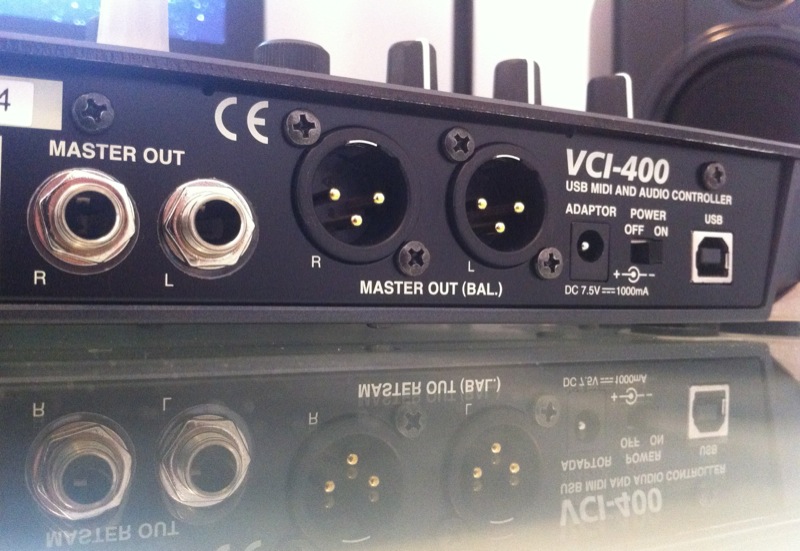
I am of the school of thought that most DJ controllers past the very cheap nowadays sound pretty good, but this controller sounded truly wonderful on both headphones, via higher-end computer monitor speakers (M-Audio AV40s) and via some Reloop ADM-5 monitors we happened to have in the office for testing. It is clear that Vestax has spent money on getting the sound hardware installed and set up right in this unit, and it shows.
DJing with this thing is a dream. I think the Vestax jogwheels are the best in the business, because they feel more like using vinyl than any other, so that’s a major plus point to start with. The faders all feel great: the channel faders have just the right degree of stiffness, and the crossfader is nice and loose (all are removable for replacement by removing a plate from the underside, by the way).
The filter knobs predictably feel awesome in use, and despite the controller featuring a myriad of controls, the spacing is just right. There are VUs built into the faders as well as the master VUs (although the former have no red warning bars being green all the way), which gives you a winning amount of feedback on your sound level settings. In short, for basic digital DJing, it’s excellent to use.
However, let’s be completely honest about this: This unit is screaming out to be custom mapped. Vestax as much as admits that the supplied mappings are just to get you going. Retail models apparently come with overlays for the supplied software mappings and also a blank overlay for you to label your own mapping on, and this is how most DJs who are considering this controller will want to use it. It is, in that way, a natural successor to the Vestax VCI-100 – the original “controllerist’s” DJ controller.
The mode buttons on the front in particular give you three sets of functions for the tactile performance pads at the front, so you can use the same pads to trigger samples, control hot cues or anything else you wish – and the pads are colour-coded so you know instantly which mode you’re set to.
You’re probably going to want to invest in a copy of Rainer G Haselier’s Traktor Bible to get your head around mapping this thing, for sure, but once you do, you have a head-spinning potential number of options.

The eight performance buttons above each deck (which are hard, and click when pushed, unlike the softer pads below) plus the four smaller buttons underneath, alone give you 24 extra functions each side when you include the shift functionality.
Whether you use them for loop rolls, sample triggers, or complex multiple Midi messages (to control stuff that frankly is way beyond what I’d ever want or need to do), point is that they’re there and screaming to be utilised. You could even use them to control completely different software, so come up with a hybrid Traktor / Ableton mapping, for instance. Want to control your lighting as well as your DJ software, all from one controller? The VCI-400 could do that too.
The routing works exactly as advertised, with the ability to route the external inputs either through decks C and D of Traktor (so forfeiting sample decks or four-deck control, of course) or straight to master out. Same with the microphones: C and D or master out. So you’ve got some either/or situations going on here. It’s certainly not as flexible as having “real” analogue mixing functions.
Conclusion
We’ve not had chance to really get stuck into this controller yet, as it’s one of the most complex we’ve ever been sent to review. However we can tell you now that for DJing, it is a joy – how couldn’t it be with the quality of hardware and the wonderful Vestax jogs? Further than that, the potential is blatantly clear: Mappers, hackers and hardcore controllerists need look no further, as their dream controller is now right in front of them.
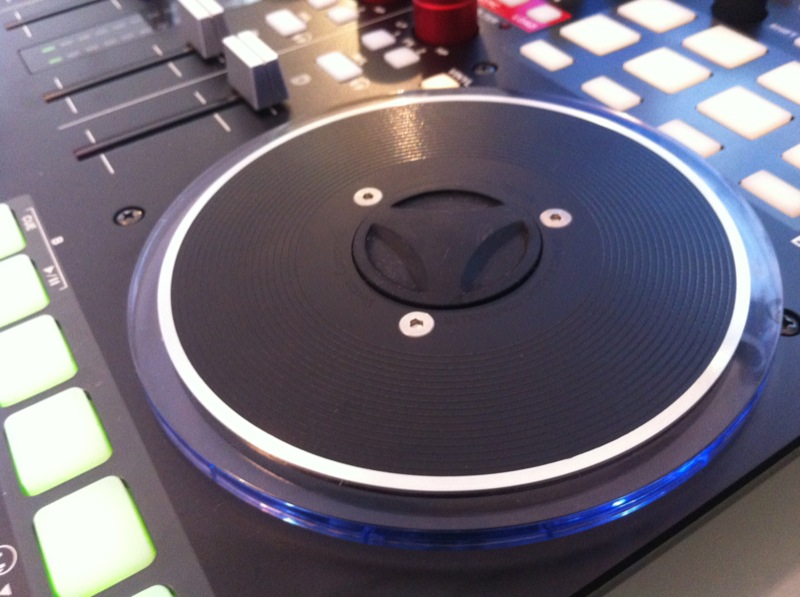
In the world of the gigging DJ, though, there are opportunities missed here. Having standalone mixer functionality would have been fantastic, as would having the ability to add record decks as well as line inputs. Due to the lack of comprehensive analogue controls, there are no EQs for the microphones. And a blatant ball-drop is the lack of booth outputs; that is going to be a deal-breaker for many working DJs.
Also one has to ask: Why doesn’t this play nicely with Serato ITCH? Serato ITCH 2.0 now comes with sample decks. There is not a single controller on the market at the time of writing that can control those sample decks. This is the first controller that could – and yet it comes only with Serato Intro.
What would be good would be an ITCH version of it (no point paying for software if you won’t use it), because that would fill a clear gap in the market for a properly configured four-deck Serato ITCH 2.0 controller.
However, I suspect none of this is going to matter to the controllerist who has been waiting for a controller like this to come along. Hardcore controllerists (or the professional performance DJ with a digital workflow that needs to be highly customised, possibly across more than one software package) both don’t really need a lot of input / output flexibility – and if they did, they’d probably buy Allen & Heath gear and be done with it. No, what these people need is great sound, fantastic build, and a shedload of controls. And that’s exactly what the Vestax VCI-400 provides.
The best all-round DJ controller yet? No. A controllerist’s dream? Absolutely.
Is this the controller you’ve been waiting for? Would you miss a booth control? Do you think Vestax has finally made a worthy successor to the VCI-100? Please let us know your thoughts in the comments.








